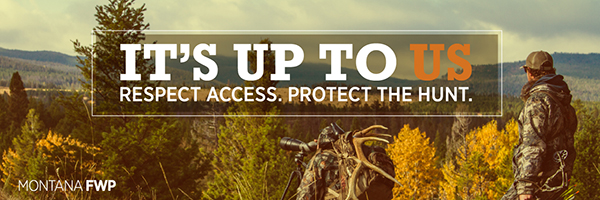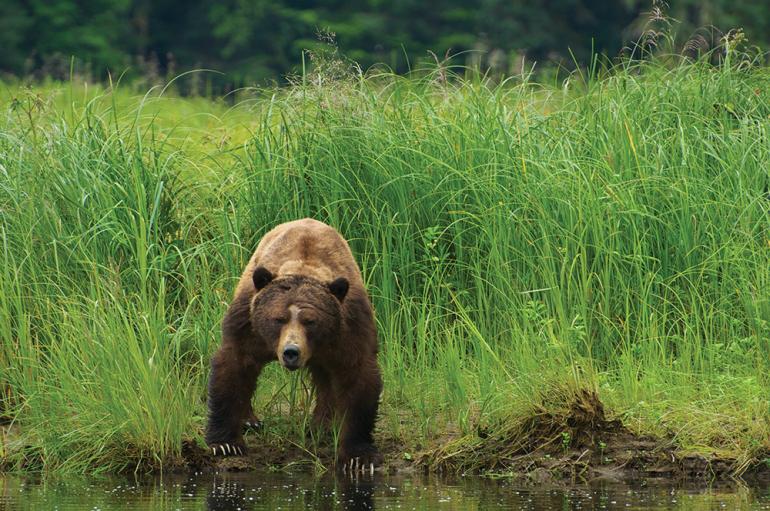Staying Sharp
Tips & tricks in bear country.
We are lucky to live in the great state of Montana for countless reasons, including this: bears live here, too. As grizzly-bear populations expand back into their historic range, the possibility of crossing paths with one is increasing. Bears prefer to avoid people. Usually, they run away before we even see them. But when we cross into their personal space—be it by surprise or not—and threaten their food or cubs, an encounter can look much different.
Hundreds of conflicts between bears and humans occur every year. Many conflicts resulting in dead bears are preventable. It is our responsibility to educate ourselves, so we can keep ourselves safe and bears wild.
Activities like trail running and mountain biking are more popular than ever, and hunting continues to be a beloved Montanan tradition, but all three of these activities are risky and require extreme vigilance in bear country. This past summer was one of the hottest on record. Water is scarce, vegetation is dry, berry crops are low, and wildlife is more stressed than normal. Being bear-aware has never been more important.
Before You Go
Learn about bear behavior and biology. Every encounter is different. Know the difference between black and grizzly bears: what they feed on at different times of the year, where they’re typically located each season, and how to identify a bear’s mood.
Contact local agencies like FWP and the Forest Service to check for recent bear activity. Practice drawing and using your bear spray regularly. Inert cans are advisable for practice.
In the Field
Always carry bear spray—everyone in the group. Keep it accessible, know how to use it, and check the expiration date. Don’t forget to remove the zip-tie holding the safety on before going into the field.
Make noise. Use your voice, speaking loudly and with confidence: “Hey bear!” Be more vocal and alert when traveling into the wind, where your line of sight is compromised, and in prime bear habitat: corners, dense vegetation, forest edges, ridgelines, riparian areas, fresh berry patches, etc.
Travel in a tight group of three or more and stay within sight of each other. Never run from a bear. Bears can sprint at over 35 miles per hour. Running away could trigger a chase response.
Keep food attractants secured. Look for sign—tracks, scat, fresh kills, digging, carcasses, and scavengers such as crows and ravens. Alert other hunters or recreationists if you see fresh sign or encounter a bear. Don’t wear ear buds. Be wary of your dog’s whereabouts and keep him nearby, or at least within sight. Dogs are rarely an asset in bear country. It is advised to keep them on a leash, or, under strict voice command if that is how you consistently control them.
If You Encounter a Bear
Stop, stand your ground, and don’t make sudden movements or turn away. Get your bear spray out and ready to use. If the bear is stressed and acting defensively, speak in a calm voice. Signs of stress include vocalizing, salivating, teeth popping, swaying head from side to side, and bluff charging.
If the bear is acting predatory—ears perked up and facing forward, looking curious, or stalking you—speak in a commanding voice, throw rocks in the bear’s direction, or move toward it. This bear will not show signs of stress.
Use bear spray if the bear approaches. The bear must be no farther than 30 feet away for spray to be effective. Use both hands and don’t use the whole canister at once. Build a wall between you and the bear. Aim low to the ground at its mouth, eyes, and nose. Back away slowly. If a defensive bear makes contact, play dead with your stomach on the ground and hands behind your head until the bear is gone. If a predatory bear makes contact, fight for your life.
Trail Runners & Mountain Bikers
Slow down! Prioritize safety over your time. Your reaction time is significantly compromised when traveling at faster paces. Look up—bears use trails, too. Avoid traveling at dusk and dawn. Keep your bear spray on your body. You may be separated from your bike if a bear attacks, so having it in a water-bottle mount won’t help. (A great holster option is the Scat belt, which places the spray on your lower back, out of the way.) Put your bike between you and the bear if necessary. And remember that you can never make too much noise.
Hunters
Heighten your sense of smell, sight, and sound. Trust your gut. Pistols are a tool for self-defense, but bear spray has proven more effective. Mystery Ranch makes a great holster for your backpack’s waistbelt, and FHF Gear has one that fits under your bino harness.
Frequently stop and assess your surroundings. Avoid moving through cover and forest edges. Always have at least one person in your party keep watch for bears when butchering. Butcher meat and leave gut piles in the open to avoid a surprise encounter with other hunters.
Make noise when not actively hunting. Know that some bears associate a gunshot with food. Should you have to leave and come back, Danielle Oyler from FWP suggests putting a stick in the carcass to know if an animal has fed on it. Get meat home as quickly as possible. If camping, hang meat at least 100 yards from camp and secure other food attractants at camp, including livestock feed. Utilize electric fencing at camp and around your meat hang.
Resources
Staying Safe in Bear Country (video) – bearbiology.org
Hunting Safely in Grizzly Country (video) – wyoga.org
Bear Attacks: Their Causes and Avoidance (book) by Stephen Herrero – Lyons Press
Interagency Grizzly Bear Committee – igbconline.org
International Association for Bear Research and Management – bearbiology.org
Montana Fish, Wildlife & Parks – fwp.mt.gov
Blakeley Adkins spent 11 years as a bear-viewing guide for Great Bear Lodge on the central coast of British Columbia. She has spent countless hours observing grizzlies in the wild interacting with each other and humans. She currently works for the Greater Yellowstone Coalition’s wildlife program and is passionate about finding ways for bears and people to coexist.















